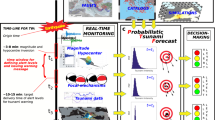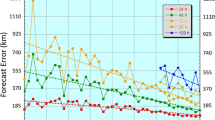Abstract
A version of our situation-dependent intensity prediction (SDIP) is proposed for operational application after three modifications: (i) Ten historical track analogs are matched with Joint Typhoon Warning Center (JTWC) official track forecasts rather than besttracks; (ii) Giving two times as much weight to the 72 h — 120 h portion of the track as to the 0–72 h portion to give higher rankings for analog tracks with similar landfall or recurvature positions and timing; and (iii) Weighting both the intensity prediction technique and a new intensity spread guidance product according to new rankings of the track analogs rather than assuming all track analogs are equally likely. These special matchings and weightings of the track analogs in this weighted-analog intensity (WANI) add skill in the 72–120 h forecast intervals in regions where landfalls occur. Viability as an operational technique is demonstrated as the WANI has only 1 kt larger mean absolute errors than the JTWC intensity errors from 12 h through 72 h, and the WANI is 5 kt (20%) better at 120 h. The WANI rank-weighted intensity spreads each 12 h among the 10 best historical track analogs are processed to reduce any intensity bias and calibrated to reduce (increase) the over-determined (under-determined) intensity spreads at early (later) forecast intervals. Thus, the situation-dependent intensity spread guidance is generated that will include about 68% of the verifying intensities at all forecast intervals. Four examples of the WANI intensity predictions and intensity spread guidance are presented to illustrate how the forecaster might use this information in potential landfall and intensity bifurcation situations.
Similar content being viewed by others
References
DeMaria, M., C. R. Sampson, J. A. Knaff, and K. D. Musgrave, 2014: Is tropical cyclone intensity guidance improving?. Bull. Amer. Meteor. Soc., doi:10.1175/BAMS-D-12-00240.1.
Elsberry, R. L., and H.-C. Tsai, 2014: Situation-dependent intensity skill metric and intensity spread guidance for western North Pacific tropical cyclones. Asia-Pac. J. Atmos. Sci., doi:10.10007/s13143-014-0018-5, in press.
Goerss, J., and C. Sampson, 2014: Prediction of consensus tropical cyclone intensity forecast error. Wea. Forecasting, 29, 750–762, doi:10.475/WAF-D-13-00058.1, in press.
Knaff, J. A., M. DeMaria, C. R. Sampson, and J. M. Gross, 2003: Statistical, five-day tropical cyclone intensity forecasts derived from climatology and persistence. Wea. Forecasting, 18, 80–92.
Author information
Authors and Affiliations
Corresponding author
Rights and permissions
About this article
Cite this article
Tsai, HC., Elsberry, R.L. Applications of situation-dependent intensity and intensity spread predictions based on a weighted analog technique. Asia-Pacific J Atmos Sci 50, 507–518 (2014). https://doi.org/10.1007/s13143-014-0040-7
Received:
Accepted:
Published:
Issue Date:
DOI: https://doi.org/10.1007/s13143-014-0040-7




